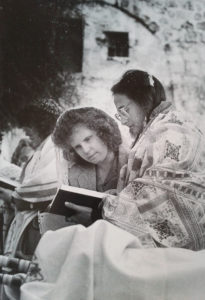Who’s entitled to pray, and where?
The Women of the Wall originated in 1988 as a Rosh Hodesh gathering of women who wanted to pray together at the Western Wall in Jerusalem. They wanted to be able to pray in a tallit and tefillin and read from the Torah in women-led and women-only services, so as to comply with Orthodox Jewish religious law. Who would have thought that, nearly 25 years later, this would still be such a fraught issue? Today, women still meet every month to celebrate Rosh Hodesh—only now with police protection because of an April 25 Jerusalem District Court decision that they are not violating the law by exercising their religious freedom. And the right to pray at the Wall as one chooses has become a bellwether for other kinds of religious and civil liberty issues in the State of Israel.
Women of the Wall, 2013
Thousands of ultra-Orthodox Jews tried to block a liberal women’s group from praying at the Western Wall on Friday morning [May 10], creating a tense standoff in the latest flash point of a broader battle over religion and identity that has engulfed Israel…
Rabbi Israel Eichler, an ultra-Orthodox member of Parliament, warned that “if the state of Israel fights” the ultra-Orthodox, in Hebrew called Haredim, “it may win, but it will be erased from the face of the Earth.”
“There were thousands of seminary girls there today,” he said. “Each one of them will have 10 children. That is our victory.”…
Menachem Friedman, a sociology professor at Bar Ilan University who has studied the Haredi society, said that while a universal military draft and cut in subsidies are more substantive issues, “gender is the most vulnerable.”
“The most threatening thing for the Haredi society is the mixture,” Professor Friedman said. “Sex is always something we can’t control—we have to defend against it, we have to separate, to make it very clear separation between men and women. Why? Because sex is really penetrating inside everyone, even the most sacred man is not protected. That is the main idea of ultra-Orthodoxy.”
From “Standoff at Western Wall Over Praying by Women” by Jodi Rudoren for the New York Times, May 10, 2013.
 The Back Story: Women of the Wall, 1989
The Back Story: Women of the Wall, 1989
Amy Stone, in a May 9, 2013, Lilith blog post:
My one ongoing—up to the present—connection to the Wall has been my diminishing supply of Women of the Wall greeting cards with a black-and-white photograph by Barbara Gingold, dated 1989. In this first gathering, women sweetly read from prayer books in front of the Wall. At least one is wearing a traditional tallit and a kippah. On the back: “Proceeds from the sale of this card help support the Women of the Wall in their efforts to advance the status of women in Judaism.” Thanks for hanging in there, Women of the Wall.
Barbara Gingold responds:
I’d say that Rivka Haut (L.) and Geela Rayzel Robinson (now Raphael) (R.) were reading the Torah that remarkable day with more determination than sweetness. When I shot that picture—after years of photographing Jewish women’s events from the late 1960s on, including the first Jewish women’s prayer group, the first Jewish feminist conferences in New York and in Israel, even the first meetings of Lilith’s future editors—I knew that this moment at the Kotel was historic. The thought went through my head: “This is it, the culmination. Now I can stop taking pictures.”
Little did I imagine that 25 years or so of battles over the Wall would follow, leaving me (and many other Israelis) alienated from the place, furious that the ultra-Orthodox appropriation of what had been the national as well as the spiritual heart of Israel led the rest of us to simply abandon or flee it. The battle’s not won yet. But I want to thank all of WoW’s overseas supporters for their help all these years. This has been an empowering example of Israel-Diaspora relations and interdependence—none of us could have done what we did without our counterparts overseas.




